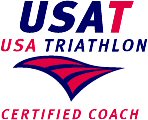6 FAQ's to Keep In Mind for your Race Day Swim
by Kevin Koskella, www.triswimcoach.com
- Should I wear a wetsuit?
- It depends on if wetsuits are allowed in the race. Most of the age group races allow wetsuits. In this case, by all means, use a wetsuit! You will not only be able to withstand cold water, but you will also be given the gift of buoyancy by your apparel- which will make it a lot easier to get through the swim.
- Can I swim another stroke besides freestyle?
- Yes. Although freestyle is the fastest and most common stroke in triathlon, beginners may benefit from an occasionally few strokes of backstroke or breastroke to regain their breath.
- It's my first race. Where should I line up at the beginning of the race?
- Stay towards the back and to the outside (away from the first buoy). If you start in the pack, you will get clobbered, and likely lose more energy fighting against the conditions than if you get some cleaner water and take the first buoy a little wider.
- Should I use a heart rate monitor?
- If you are used to using a heart rate monitor when you train, it may help you during a triathlon at certain points, like transitions, to keep your heart rate from getting too far out of whack. However, for the swim, it will be impossible to look at your watch and keep track of your heart rate while you swim and try to see where you're going at the same time.
- How often should I "sight"?
- First of all, find out how many buoys there are and learn the course before your race. This will limit the number of times you need to pop your head up to see where you are. Ideally you can find an object- like the swimmer in front of you, or the next buoy, to focus on when you lift your head up. Otherwise, taking a peek every 6-8 arm cycles should be adequate. Also, wear goggles with clear lenses for optimum vision during your race.
- How often should I breathe during a race swim?
- f this is your first race, don't get hung up on this. Breathe when you need air, even if that means every 2 strokes. However, as you get a race or two under your belt, learn to bilateral breathe- or every 3 strokes. This will help with navigation, and to keep you a little more straight.
About the Author
Kevin coaches masters and triathlete swimmers in San Diego, CA. He operates the website www.TriSwimCoach.com, a resource for beginning through intermediate level triathletes looking for help with swimming. The site features a free email newsletter offering tips and articles on triathlon swimming. Kevin has also written an electronic book titled "The Complete Guide to Triathlon Swimming" which is sold on his website in downloadable form.








